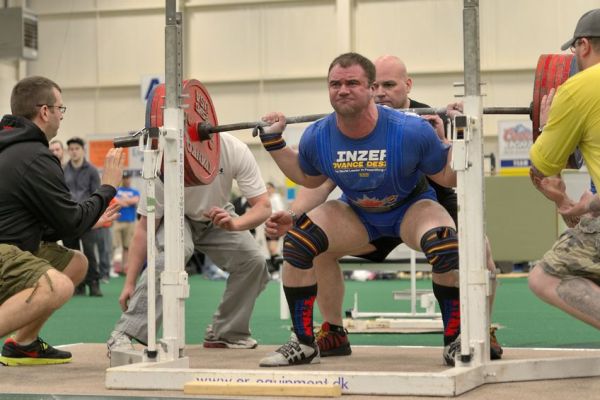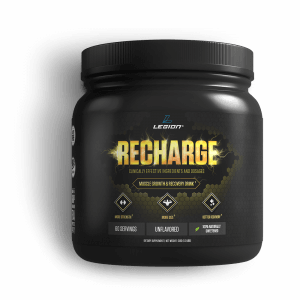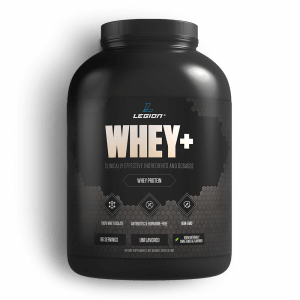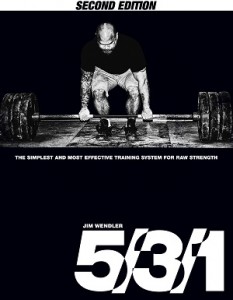I used to have some funny ideas about strength training.
I thought it was just for getting stronger, not bigger.
I thought it was inherently dangerous and maybe even a recipe for injury.
And I thought that traditional bodybuilding workouts were better for building the muscular, proportionate physique I wanted.
Well, I was wrong.
Strength training is fantastic for building muscle, it doesn’t have to increase the risk of injury, and it’s far more effective for building an attractive physique than the high-rep, “pump” style of bodybuilding training.
You see, here’s a picture of me after about 7 years of hopping from one bodybuilding program to another:

Not very impressive given the sheer amount of time and work I had put in.
Soon after this picture was taken, I decided to take a new approach, though.
I decided to focus a lot more on strength training and lot less on the crap I read about in bodybuilding magazines.
And the results? Well, here’s a shot of me about 2.5 years later:

(And yes, I learned how to diet along the way too!)
As you can imagine, I never looked back.
Through my books and blogs, I’ve since helped hundreds of thousands of people start their own strength training journeys and personal transformations.
And in this article, we’re going to break down one of the more popular programs, Jim Wender’s 5/3/1 routine, and see how it works.
This program is a great way to skyrocket your strength, break through weightlifting plateaus, and, as you’ll soon experience, have a blast hitting PRs and feeling like superman (or woman!) lifting huge weights. 🙂
Another great benefit of 5/3/1 and of most strength training programs is you don’t have to live in the gym to see results. 3 to 4 workouts per week that last 45 to 60 minutes is all it takes.
So, if I’ve whetted your appetite for some heavy lifting, good. Let’s get to it.
- How to Calculate Your One-Rep Maxes
- How 5/3/1 Works
- The Wendler 5/3/1 Warm-Up
- How to Progress on the 5/3/1 Program
- What to Do When You Get Stuck
- 5/3/1 Assistance Work
- What About Supplements?
- What do you think about Wendler's 5/3/1 system for strength training program? Have anything else to add? Let me know in the comments below!
Table of Contents
How to Calculate Your One-Rep Maxes

Your “one-rep max,” or “1RM,” is the amount of weight that you can lift for one, and only one, rep with while maintaining proper form.
These are real, right now numbers—not past accomplishments or current wishes.
To follow the 5/3/1 program, you’ll need to know your 1RMs for your squat, deadlift, bench press, and military press.
Fortunately, you don’t have to find them through trial and error—you can simply calculate them based on how many reps you can perform with a lighter weight. The math is simple too.
To find your 1RM for a given lift, use an amount of weight that allows for about 4-6 reps, and use the following equation:
Weight x Reps x .0333 + Weight = Estimated 1RM
For example, if I can squat 335 for 5 reps, then the equation looks like this:
(355 x 5) = 1775 x .0333 = 59 + 355 = 414
Practically speaking, I would round that number either down to 410 or up to 415, but that’s the simplicity of it.
Now, manually calculating all your 1RMs can be quite tedious, so I have a nifty calculator for you to use…
How 5/3/1 Works

5/3/1 is extremely popular because it’s easy to understand, it doesn’t require any special equipment, the workouts are relatively short, and it’s very effective.
Here’s how it works.
You train 3 to 4 times per week.
5/3/1 has you do one of four workouts on your training days:
1. Squat and assistance work.
2. Bench Press and assistance work.
3. Deadlift and assistance work.
4. Overhead Press and assistance work.
You perform each of these workouts once to complete what is called a “wave.”
Here’s how it’s commonly laid out:
| DAY 1 | DAY 2 |
| Warm-Up | Warm-Up |
| Overhead Press | Deadlift |
| Assistance Work | Assistance Work |
| DAY 3 | DAY 4 |
| Warm-Up | Warm-Up |
| Bench Press | Squat |
| Assistance Work | Assistance Work |
Each “mesocycle” (a fancy term for a training phase that lasts 2 to 6 weeks) of 5/3/1 consists of four waves.
That is, you will do each of the workouts 4 times to complete a mesocycle, at which point you will start over again from the beginning.
Here’s how the mesocycle works:
| WAVE 1 | ||
| SET | % OF 90% OF 1RM | REPS |
| 1 | 65% | 5 |
| 2 | 75% | 5 |
| 3 | 85% | 5+ |
| WAVE 2 | ||
| SET | % OF 90% OF 1RM | REPS |
| 1 | 70% | 3 |
| 2 | 80% | 3 |
| 3 | 90% | 3+ |
| WAVE 3 | ||
| SET | % OF 90% OF 1RM | REPS |
| 1 | 75% | 5 |
| 2 | 85% | 3 |
| 3 | 95% | 1+ |
| WAVE 4 | ||
| SET | % OF 90% OF 1RM | REPS |
| 1 | 40% | 5 |
| 2 | 50% | 5 |
| 3 | 60% | 5 |
Note that 5/3/1 works with a percentage of 90% of your one-rep max, not a percentage of your 5-rep max like other strength programs.
Also, the sets with + sign indicate that you should get as many reps as you can.
As you see, there isn’t much to the core 5/3/1 workouts.
This low volume approach is one of the common critiques of the program, but I feel much of the criticism is unfounded.
It isn’t that 5/3/1 doesn’t work…it’s just not for everyone.
If you have years of strength training under your belt, 5/3/1 probably isn’t the right choice for you. But you probably wouldn’t be here if that were the case.
If you’re new to strength training, though, you can do great with this program.
This is especially true if you do the right assistance work in addition to the core lifts, which would give you something similar to my Bigger Leaner Stronger program.
BLS is a basic strength training program with additional assistance and isolation work necessary for building a proportionate physique.
Now, how many workouts you do each week will determine how many weeks each mesocycle lasts.
If you do 4 workouts per week, the mesocycle will last 4 weeks. If you do 3 workouts per week, it will last 5 weeks and 1 day (and you’ll see why in a minute).
Here’s how to program your workouts if you’re training 4 days per week:
| WEEK 1 | ||
| DAY | EXERCISE | WAVE |
| 1 | Overhead Press | 1 |
| 2 | Deadlift | 1 |
| 3 | Bench Press | 1 |
| 4 | Squat | 1 |
| WEEK 2 | ||
| DAY | EXERCISE | WAVE |
| 1 | Overhead Press | 2 |
| 2 | Deadlift | 2 |
| 3 | Bench Press | 2 |
| 4 | Squat | 2 |
| WEEK 3 | ||
| DAY | EXERCISE | WAVE |
| 1 | Overhead Press | 3 |
| 2 | Deadlift | 3 |
| 3 | Bench Press | 3 |
| 4 | Squat | 3 |
| WEEK 4 | ||
| DAY | EXERCISE | WAVE |
| 1 | Overhead Press | 4 |
| 2 | Deadlift | 4 |
| 3 | Bench Press | 4 |
| 4 | Squat | 4 |
And if you train 3 days per week, it takes 5 weeks and 1 day because you still have to do all 16 workouts to complete the mesocycle and you can’t double up exercises on a training day.
Here’s a simple way to program it:
| WEEK 1 | ||
| DAY | EXERCISE | WAVE |
| 1 | Squat | 1 |
| 2 | Bench Press | 1 |
| 3 | Deadlift | 1 |
| WEEK 2 | ||
| DAY | EXERCISE | WAVE |
| 1 | Overhead Press | 1 |
| 2 | Squat | 2 |
| 3 | Bench Press | 2 |
| WEEK 3 | ||
| DAY | EXERCISE | WAVE |
| 1 | Deadlift | 2 |
| 2 | Overhead Press | 2 |
| 3 | Squat | 3 |
| WEEK 4 | ||
| DAY | EXERCISE | WAVE |
| 1 | Bench Press | 3 |
| 2 | Deadlift | 3 |
| 3 | Overhead Press | 3 |
| WEEK 5 | ||
| DAY | EXERCISE | WAVE |
| 1 | Squat | 4 |
| 2 | Bench Press | 4 |
| 3 | Deadlift | 4 |
| WEEK 6 | ||
| DAY | EXERCISE | WAVE |
| 1 | Overhead Press | 4 |
| 2 | Rest | |
| 3 | Rest | |
As you can see, both the 4- and 3-day splits have you performing each of the workouts 4 times before restarting.
The Wendler 5/3/1 Warm-Up

You probably noticed earlier that workouts start with a warm-up routine.
Warming up properly is very important when you’re lifting heavy weights, so don’t skip this.
Here’s how the 5/3/1 warm-up works:
Warm-Up Set #1
40% of your 1RM x 5
Warm-Up Set #2
50% of your 1RM x 5
Warm-Up Set #3
60% of your 1RM x 3
You rest for 60 to 90 seconds in between each warm-up set.
Once you’ve performed these warm-up sets, you are ready to begin your heavy lifting.
How to Progress on the 5/3/1 Program

Slow, steady progression is the name of the game with 5/3/1, and Wendler keeps progression very simple.
You begin each new mesocycle by increasing your 1RM weights by 5 pounds for upper-body lifts, and 10 pounds for lower-body lifts.
Note that I said “your 1RM weights,” not your weights in the gym.
That is, you’re increasing the numbers that you’re using to calculate your 5/3/1 lifts, not the amounts of weight you’re actually lifting.
For example, let’s say you used the following 1RM numbers to calculate the mesocycle you just finished:
- Deadlift: 400
- Squat: 400
- Military: 225
- Bench Press: 300
For your next mesocycle, you would calculate your lifts using the following 1RM numbers:
- Deadlift: 410
- Squat: 410
- Military: 230
- Bench Press: 305
You keep on increasing weights this way until you get stuck, which Wendler says will happen.
What to Do When You Get Stuck

When you finally do stall, Jim simply recommends that you drop your current 1RMs by 10%, re-calculate your working weights, and keep going.
For example, if, over the course of several months, you’ve increased your squat 1RM from 400 to 430 pounds and now you’re stuck, you simply recalculate your next mesocycle using 90% of 430 (390) instead of trying to move up to 440.
By following this “two steps forward, one step back” approach, you’re able to keep your weights moving up over time and avoid the dreaded long-term plateau.
5/3/1 Assistance Work

“Assistance work” refers to exercises done other than the four the program is built around. How much assistance work you do is up to you, but it’s done for one or more of the following reasons:
- Strengthen weak parts of the body
- Help increase the four core lifts
- Ensure your body develops in a balanced and symmetrical fashion
- Build more muscle
If you’re familiar with my Bigger Leaner Stronger program, you’ll feel right at home with almost every assistance exercises that Wendler recommends:
- Dips, weighted if possible
- Chin-ups or pull-ups
- Dumbbell Rows
- Barbell Rows
- Barbell Shrugs
- Dumbbell Bench Press
- Dumbbell Military Press
- Lunges
- Leg Press
In fact, Wendler’s recommendations are so similar to my list of “approved exercises” in Bigger Leaner Stronger that you can just use it as a guide.
In terms of programming your workouts, the most popular assistance routine is one Wendler calls “Boring But Big.”
It involves performing the sets and reps dictated by the program, followed by the same exercise for 5 sets of 10 reps, and by another assistance exercise for 5 sets of 10 reps.
For example, your Squat day might go like this:
Squat
3 sets of 5 reps (or whatever you’re currently doing for your wave)
Squat
5 sets of 10 reps
Lunge
5 sets of 10 reps
In terms of how much weight you should use for the 10-rep sets, Wendler recommends that you start with light weights—40-50% of your 1RM—and gradually work up from there.
How high you ultimately go is up to you, but I would recommend working up to using an amount of weight that allows for at least 8, but no more than 10 reps.
Wendler gives several other assistance routines as well as advice on how to program them properly in his book, which I highly recommend you read if you’re going to do his program.
It’s a great read, you’ll learn more about the ins and outs of the system, and you’ll support his work.
What About Supplements?

I saved this for last because, quite frankly, it’s far less important than proper diet and training.
You see, supplements don’t build great physiques–dedication to proper training and nutrition does.
Unfortunately, the workout supplement industry is plagued by pseudoscience, ridiculous hype, misleading advertising and endorsements, products full of junk ingredients, underdosing key ingredients, and many other shenanigans.
Most supplement companies produce cheap, junk products and try to dazzle you with ridiculous marketing claims, high-profile (and very expensive) endorsements, pseudo-scientific babble, fancy-sounding proprietary blends, and flashy packaging.
So, while workout supplements don’t play a vital role in building muscle and losing fat, and many are a complete waste of money…the right ones can help.
The truth of the matter is there are safe, natural substances that have been scientifically proven to deliver benefits such as increased strength, muscle endurance and growth, fat loss, and more.
As a part of my work, it’s been my job to know what these substances are, and find products with them that I can use myself and recommend to others.
Finding high-quality, effective, and fairly priced products has always been a struggle, though.
That’s why I took matters into my own hands and decided to create my own supplements. And not just another line of “me too” supplements–the exact formulations I myself have always wanted and wished others would create.
I won’t go into a whole spiel here, but if you want to learn more about my supplement line, check this out. (And if you’d like to know exactly what supplements to take to reach your fitness goals, take the Legion Supplement Finder Quiz.)
For the purpose of this article, let’s just quickly review the supplements that are going to help you get the most out of your butt (and other) workouts.
Creatine
Creatine is a substance found naturally in the body and in foods like red meat. It’s perhaps the most researched molecule in the world of sport supplements–the subject of hundreds of studies–and the consensus is very clear:
Supplementation with creatine helps…
You may have heard that creatine is bad for your kidneys, but these claims have been categorically and repeatedly disproven. In healthy subjects, creatine has been shown to have no harmful side effects, in both short- or long-term usage. People with kidney disease are not advised to supplement with creatine, however.
If you have healthy kidneys, I highly recommend that you supplement with creatine. It’s safe, cheap, and effective.
In terms of specific products, I use my own, of course, which is called RECHARGE.

RECHARGE is 100% naturally sweetened and flavored and each serving contains:
- 5 grams of creatine monohydrate
- 2100 milligrams of L-carnitine L-tartrate
- 10.8 milligrams of corosolic acid
This gives you the proven strength, size, and recovery benefits of creatine monohydrate plus the muscle repair and insulin sensitivity benefits of L-carnitine L-tartrate and corosolic acid.
Protein Powder
You don’t need protein supplements to gain muscle, but, considering how much protein you need to eat every day to maximize muscle growth, getting all your protein from whole food can be impractical.
That’s the main reason I created (and use) a whey protein supplement. (There’s also evidence that whey protein is particularly good for your post-workout nutrition.)

WHEY+ is 100% naturally sweetened and flavored whey isolate that is made from milk sourced from small dairy farms in Ireland, which are known for their exceptionally high-quality dairy.
I can confidently say that this is the creamiest, tastiest, healthiest all-natural whey protein powder you can find.
Pre-Workout Drink
There’s no question that a pre-workout supplement can get you fired up to get to work in the gym. There are downsides and potential risks, however.
Many pre-workout drinks are stuffed full of ineffective ingredients and/or minuscule dosages of otherwise good ingredients, making them little more than a few cheap stimulants with some “pixie dust” sprinkled in to make for a pretty label and convincing ad copy.
Many others don’t even have stimulants going for them and are just complete duds.
Others still are downright dangerous, like USPLabs’ popular pre-workout “Jack3d,”which contained a powerful (and now banned) stimulant known as DMAA.
Even worse was the popular pre-workout supplement “Craze,” which contained a chemical similar to methamphetamine.
The reality is it’s very hard to find a pre-workout supplement that’s light on stimulants but heavy on natural, safe, performance-enhancing ingredients like beta-alanine, betaine, and citrulline.
And that’s why I made my own, and I called it PULSE.

What makes PULSE special, you ask?
- Clinically effective dosages of 5 natural, performance-enhancing ingredients backed by peer-reviewed, well-designed, and well-executed research: caffeine, theanine, citrulline malate, beta-alanine, betaine, and ornithine.
- No proprietary blends.
- No other stimulants than caffeine.
- No artificial sweeteners, flavors, or food dyes.
- No unnecessary fillers, carbohydrate powders, or junk ingredients.
While everyone claims to have the best pre-workout supplement on the market, I can actually back up such claim with real science, and real numbers.
And again, if you feel confused about what supplements you should take to reach your goals, take the Legion Supplement Finder Quiz to learn exactly what supplements are right for you. It’s the best way to ensure you get the most out of your supplement regimen.
What do you think about Wendler’s 5/3/1 system for strength training program? Have anything else to add? Let me know in the comments below!
+ Scientific References
- More S. Global trends in milk quality: Implications for the Irish dairy industry. Ir Vet J. 2009;62(4):5-14. doi:10.1186/2046-0481-62-S4-S5
- Fukushima M, Matsuyama F, Ueda N, et al. Effect of corosolic acid on postchallenge plasma glucose levels. Diabetes Res Clin Pract. 2006;73(2):174-177. doi:10.1016/j.diabres.2006.01.010
- Ho J-Y, Kraemer WJ, Volek JS, et al. l-Carnitine l-tartrate supplementation favorably affects biochemical markers of recovery from physical exertion in middle-aged men and women. Metabolism. 2010;59(8):1190-1199. doi:10.1016/j.metabol.2009.11.012
- Francaux M, Poortmans JR. Side effects of creatine supplementation in athletes. Int J Sports Physiol Perform. 2006;1(4):311-323. http://www.ncbi.nlm.nih.gov/pubmed/19124889. Accessed September 17, 2019.
- Bizzarini E, De Angelis L. Is the use of oral creatine supplementation safe? J Sports Med Phys Fitness. 2004;44(4):411-416. http://www.ncbi.nlm.nih.gov/pubmed/15758854. Accessed September 17, 2019.
- Poortmans JR, Francaux M. Adverse effects of creatine supplementation: fact or fiction? Sports Med. 2000;30(3):155-170. doi:10.2165/00007256-200030030-00002
- Bassit RA, Pinheiro CHDJ, Vitzel KF, Sproesser AJ, Silveira LR, Curi R. Effect of short-term creatine supplementation on markers of skeletal muscle damage after strenuous contractile activity. Eur J Appl Physiol. 2010;108(5):945-955. doi:10.1007/s00421-009-1305-1
- Eckerson JM, Stout JR, Moore GA, et al. Effect of creatine phosphate supplementation on anaerobic working capacity and body weight after two and six days of loading in men and women. J Strength Cond Res. 2005;19(4):756-763. doi:10.1519/R-16924.1
- Branch, J D. Effect of creatine supplementation on body composition and performance: a meta-analysis. Int J Sport Nutr Exerc Metab. 2003;13(2):198-226. https://www.ncbi.nlm.nih.gov/pubmed/12945830. Accessed September 17, 2019.












